News & Blog
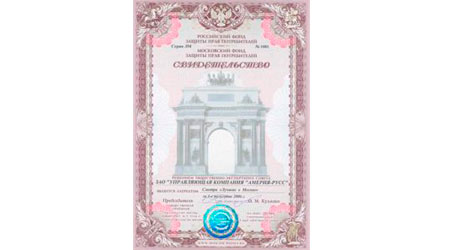

21 November 2006
21 November 2006
Новости

The decision of the public and expert council of the Russian and Moscow funds for the protection of consumers’ rights «Ameriа Russ» CJSC became the winner of the Best in Moscow review for the first half of 2006.
This certificate confirmed the highly professional work of the company «Ameria» in the sphere of trade and food production in Moscow!







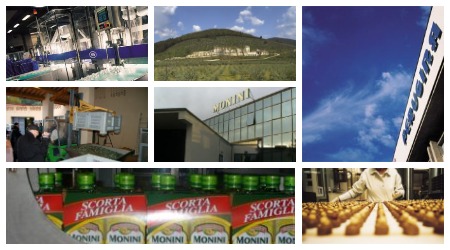

20 November 2006
20 November 2006
Новости

The company «Ameria» together with Italian companies Monini S.p.A. (Olive oil MONINI) and Nestle Perugina (chocolate BACI PERUGINA) organized a press tour for journalists of leading specialized and business publications, as well as representatives of television.
The main objective of this event was the promotion of a culture of olive oil consumption in Russia, as well as introduction of the products MONINI and BACI PERUGINA.
As a result of the tour, a number of publications and television programs on these products will be published.
Look for information in the following editions:
– «Restaurateur»
– «Chef»
– «Gastronom»
– «Moyo delo. Magazin»
– «Moyo delo. Restaurant»
– «Vitrina»
-«Bon Appetit»
– «Zdorov’e»
– «Zdorov’e ot prirodi»
– «Company»
– The newspaper «Business»
TV programs:
– «Gorod. Drugoy» (Third channel)
– «Zagranichniye shtuchki» (Domashniy TV Channel)
– Morning news broadcast (REN-TV)







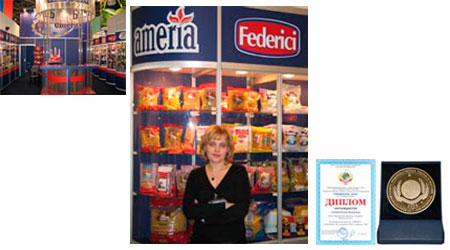

08 February 2006
08 February 2006
Новости

The international competition «Best Product – 2006», which was held during the exhibition «Prodexpo – 2006», noted the high quality of the «Ameria» pasta with a diploma and a silver medal.
Year by year, the products of «Ameria pasta factory» are awarded with high awards at international food exhibitions.







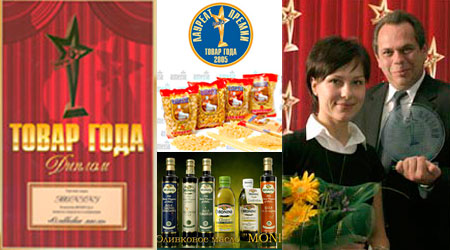

08 November 2005
08 November 2005
Новости

On November 29, 2005, the «Product of the Year-2005» prize was awarded in Moscow. In accordance with the results of the «Product of the Year – 2005» rating of the National Trade Association (NTA), our company entered the top three in terms of sales results in Russian trading enterprises.
The company’s products were presented in two categories: «Pasta» – «Ameria»
аnd «Olive oil» – «Monini».
During the ceremony, awards and diplomas were presented. Congratulations on this joyful event of all our customers, partners, distributors and suppliers!







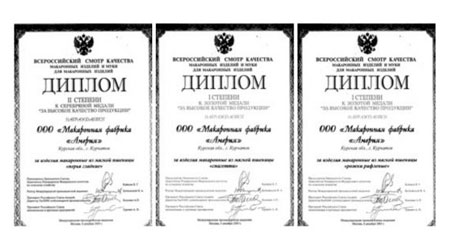

07 November 2005
07 November 2005
Новости

All-Russian review of the quality of pasta and flour for pasta has awarded the «Pasta factory Ameria» in the following nominations:
Pasta from soft wheat «Pipe rigate»
– a gold medal and a diploma of the I degree for high quality products;
Pasta from soft wheat «Spaghetti»- a gold medal and a diploma of the I degree for high quality products;
Pasta from soft wheat «Penne lisce» – a silver medal and a diploma of the second degree for high quality products.
«Ameria» pasta is again marked by high awards, which confirm their high quality and excellent taste.







10 October 2005
10 October 2005
НовостиAuthor: Sergey Kanunnikov, magazine Kommersant Dengi No. 40 (545)
Someone nicknamed «pasta» could offend, but not Italians. They, on the contrary, are proud that they know five thousand kinds of pasta and actively popularize their national dish all over the world. In their venture, the Italians were very lucky. This was confirmed by the correspondent of «Money» Sergei Kanunnikov, who visited the Italian pasta factory.
Macaroni factory
«The Russian man in Italy is unbearable! There is no normal food. For lunch, pasta, evening pasta, and so on every day: pasta, pasta, pasta … And the main thing is, they eat it raw » – with genuine pain in my voice shared my companion. Criticism of Italian gastronomy I had to listen in July on the Moscow-Togliatti train. A neighbor on the coupe, a middle-aged lady, was returning home from Italy, where she worked as a baby-sitter. The pasta was her most terrible Italian memory.
This is the first thing that came to my mind when I was invited to go to the north of Italy, to the city of Parma, to the world’s largest macaroni factory. This factory belongs to the company Barilla G. & R. Fratelli S.pa. World macaroni brand #1, Barilla this year announced the beginning of expansion to the Russian market, and as a promotion, organized with its Russian partner «Ameria» company for the chefs of the capital’s restaurants something like a gastronomic tour to their own fiefdom.
From Vnukovo to Parma airport named after Giuseppe Verdi, four hours of summer. On the way, the Italians accompanying us have time to find out that my exhausted macaroni diet friend did not lie. According to the owner of the Moscow restaurant «Adriatico» Marciano Palli, a great connoisseur of pasta, at least once a week, pasta is eaten by more than 75% of Italians. At the same time, the local culinary tradition really obliges chefs to serve pasta slightly undercooked. «So tastier and more useful: from such a paste does not get fat,» Signor Palli authoritatively states.
To convince a variety of gastronomic tourists like us about the strategically important importance of the Barilla pasta for Italians begin at the airport. There is no jam, queues and duty free – the airport is quite tiny. Visitors are greeted by a huge billboard, insisting that «Where is Barilla, there is a house.»
With this approach it was not surprising that our first serious voyage was for macaroni production. In total, Barilla has about ten factories in Europe and the USA. But this – the largest of all, a day produces hundreds of tons of macaroni of all shapes, sizes and calibers. Every hour hundreds of automatic rifles, clattering with iron, cut, pack and lay kilometers of pasta: these hundred meters – to Germany, the next – to Japan, following them – to Saudi Arabia. Wishing to impress us, Barilla Regional Director for Eastern Europe Fabio Fabris says: «At Barilla, 200,000 chickens work daily.» Like, we only consume hundreds of thousands of eggs a day, but flour … Fabio in Moscow is infrequent, otherwise it would be enough for him to say: a factory in Parma is like a sports complex “Olympic”, only for the production of pasta. Would not be mistaken for a gram.
In one of the workshops we get to the line for the production of pasta farfalle, «moths» in Italian. Tiny with the carved wings of the pasta is really very similar to small butterflies. Our guide straight from the assembly line draws a handful of moths and pours it into my palm: «Well, how?» Sensations completely unexpected. It turns out that freshly appeared pasta – hot! In addition, very soft. «Wings» of the still not dried farfalle are fragile, like the wings of dragonflies.
For an hour that we walk around the factory, we have time to make sure: pasta is a kind of national insanity. For several centuries the Italians managed to invent at least 250 kinds of pasta and about 5 thousand dishes from it. Who else would have calmed down long ago: 250 variations on the theme of flour and water – a sufficient contribution to the global culinary treasury to now rest on their laurels. The same does not sit. For example, Barilla created in Parma its own Academia Barilla, something like a gastronomic institute, developing new types of pasta and teaching chefs from all over the world correctly to cook this very pasta.
In the office of the factory we find an unexpected thing. Among the posters with Italian actors advertising the paste Barilla, mdash; Surprisingly familiar face: our Vsevolod Larionov, gently holding a pack of spaghetti in the brand-name blue-red packaging of Barilla. The picture is clearly 70-80-ies, in Russia, Barilla and then there was not, however, as well as advertising. It seems that for the employees of the factory this discovery is completely unexpected. Five minutes everyone is racking his brains over how he got here, while one of the translators does not remember: the movie was made in the mid-80s, Mr. Larionov came to Italy for filming in Mihalkiv’s film «Black Eyes». His style was very much liked by the Italians, they persuaded him.
Eating in Italian
In the evening – a practical acquaintance with Italian cuisine. As the most interesting from the point of view of gastronomic pleasures of the area, aborigines recommend strada Farini, a small street opposite the Parma municipality. In the afternoon the street is narrow, crooked and cramped. But around nine in the evening, as soon as the last shops are closed, it changes: in the dark with cotton, huge white flowers open. This is the waiters of local restaurants and cafes take out the tables in the center of the street (in the courtyard + 20 ° C) and throw white tablecloths over them. Nine evenings – it’s time for dinner, the main meal of the Italians.
The Italian concept of nutrition is a great mockery of the followers of Dr. Atkins, Michel Montignac and other dietary gurus. Absolutely incredible amount of refined carbohydrates in the form of daily pastes and pizzas Berlusconi’s compatriots abundantly chew with olive oil and savely eat up meat or fatty cheeses (50 grams of the main local cheese parmigiano reggiano contains a daily calorie rate – about 2 thousand!). About the regime generally do not have to say. During the daytime, the local population voluntarily lives on the hunger side. The entire daily diet of the average Italian is strong black coffee for the first, second and third. Well, perhaps an easy addition to it – a piece or two of bread «focaccia» (a white flat cake that is served with herbs, large sea salt and olive oil) or pizza «bianca» (a thin, almost dietary pizza flavored with just a handful of mozzarella) . Real food is an evening meal. A few antipasts (snacks) continue to actually paste and hot (fish or meat), complete with a mandatory dessert. The «right» dinner can last until eleven in the evening. In this case, the Italians, conscientiously following the age-old tradition of nutrition, manage to remain slender for envy: for three days in Italy, I do not seem to have noticed a really fat man.
Before the local restaurants can not resist. In the course is the whole arsenal of means of persuasion: appetizing still lifes in show-windows, smells, call-ringing of glasses and happy laughter of absolutely happy gourmets, coming from open doors. And at each entrance there is a large basket with fresh white mushrooms. Mushrooms are real, moist, with adherent needles and grains of sand, they smell of wood. In a word, it is impossible to resist.
In one of the restaurants I’m tempted by an unusual snack: something like a ball for ping-pong, which is served here to a glass of sparkling wine. As far as my knowledge of Italian and ignorance of the English waiter allows, I ask if the ball is edible. Instead of an answer, the waiter pins one on a toothpick and holds out: «Ping-pong ball is a huge olive in a fragrant breading». To the impossible is simple, to the impossible is delicious. I decide: thanks to at least one of this discovery, a gastronomic trip to Parma can be considered to be held.
Balm for the soul
Italians like to occasionally brag about everything and everything on their land: culture, architecture, cuisine, etc. In Parma they also did not fail to notice that the main local delicacies – parmesan cheese, the same parmigiano reggiano and parma ham prosciutto – are made by technology , Which has not changed for five or six centuries. For the sake of persuasiveness on the second day of our stay in Italy, we were taken to one of such «ancient» productions – a factory for the production of balsamic vinegar. On the spot, however, it turned out that it is difficult to name the factory: it turned out to be an ancient dwelling house belonging to the family of Zakkoli. The head of the family Signor Zakkoli is the real Italian count.
I believe, looking at Signora Zakkoli and his possession, many of my fellow travelers regretted that they were not born noblemen in Italy. A very kind impression was made by a family mansion with an area of 300 square meters. M surrounded by vineyards. As the head of the family himself explained, the basis of his noble well-being is exclusively Aceto Balsamico Tradizionale, balsamic vinegar, whose production was transferred to him from his father. However, the word «production» is somehow not very suitable for his business. Only about a hundred differently-sized barrels in the attic of a house where for decades roaches, grape must is fermented. It turns out 3,5 thousand two hundred-kg bottles of vinegar per year.
My companions judged that nowhere, except in Italy, such production would not have been possible. The whole world safely manages without this oil-like astringent liquid, using most often mayonnaise and ketchup. For Italians, balsamico is a national treasure. Probably, as in Russia oil. With this specialty they manage to season not only cheese, meat or pasta, but even ice cream. They say: balsamico is terribly useful and, like nothing else, it allows you to feel the true taste of the dish. By the way, Italians appreciate the traditional balsamic vinegar in no way lower than oil in the literal sense of the word. For example, in the «factory» of Signor Zakkoli for £ 40, you could buy a 200-milliliter bottle of balsamic 12-year aging and for £ 75- 25-year-old. The charm of vinegar production in Italy was appreciated by many. In the province of Modena, the main acetic «granary» in Italy, the number of vinegar factories is growing by leaps and bounds. Now there are about 70 of them, about 30 more are waiting for the contents of the kegs in their attics to reach the 12th anniversary. Only after this vinegar is assigned the category of tradizionale, which makes it prestigious and so expensive.
But these «competitors» are not the headache of our hospitable host. The life of Mr. Zakkoli and other «traditional» producers is poisoned by real industrial factories. Graf complained that they do not break their heads over compliance with the recipe: they manage to make their vinegar in just two years, the label «balsamico» flips on him uninterruptedly acting on the buyer and is dumped on the market at bargain prices. This is very troubling our signora. Wishing him a successful trade and buying a dozen bottles of balsamico to support the family business of Zakkoli, we start off. On the way, someone from our group decided to calculate the profitability of the vinegar business. It turned out that the old man became agitated early. With the current sales volumes for the future of at least three generations of the Zakkoli family, one can not worry: the monthly revenue from vinegar trade is not less than 15 thousand.
However, despite the love of vinegar, the Italians still remain adherents of the sweet life. Aspiration to dolce vita is one of the main features of old Italy, according to the Italians themselves, which distinguishes them from other Europeans. While on the way to the airport, one of the Italians accompanying us sighs: over the past five years, the country has changed a lot, «old Italy» is leaving. In large cities, people forgot how to live as they should: less fun, more work. Traditional and measured life with large family dinners, non-dietary food, the ability to turn an existence into pleasure and respect for the olden times is preserved only in the outback like Parma. So it is clear where to look for «real» Italy: in small towns. Just need to hurry, too fast everything is changing here.







News & Blog
Пожалуйста, оставьте адрес электронной почты, и мы вышлем вам подробный прайс-лист
Пожалуйста, оставьте адрес электронной почты, и мы вышлем вам подробный прайс-лист


Мы свяжемся с вами в ближайшее время
 Moscow
Moscow ameria@ameria.ru
ameria@ameria.ru



